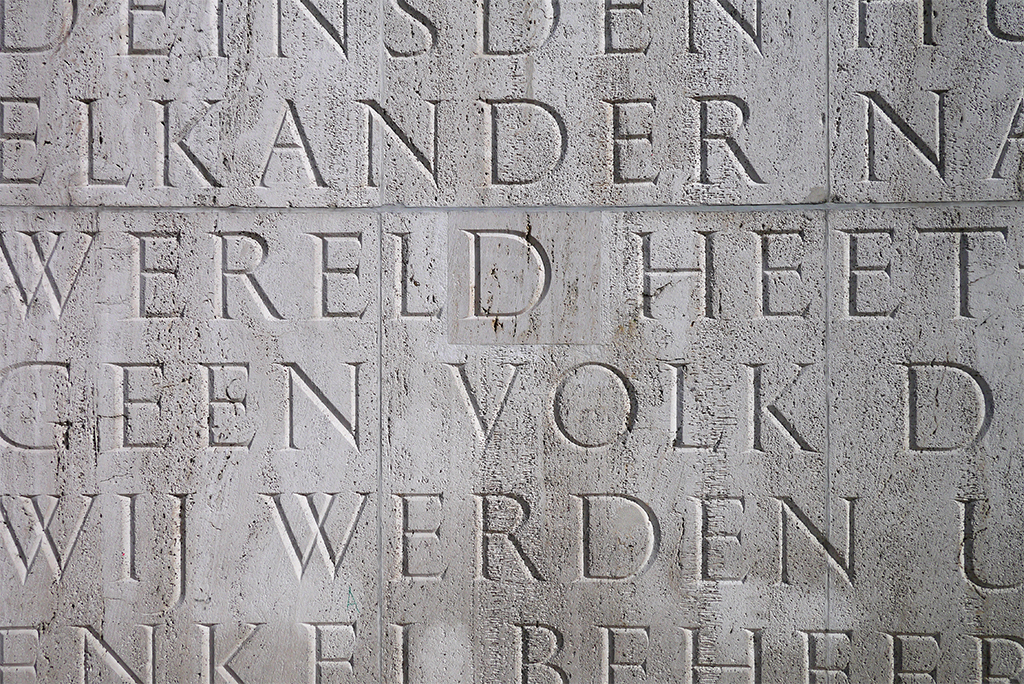Matthew Carter’s type has changed the world; ‘Top 10 (minus one)’ shows some inspirations

Typographer Matthew Carter names spotting lettering here and there among his favorite things, including Jan van Krimpen’s capitals on the Dutch World War II memorial in the center of Amsterdam. (Photo: Katherine Small Gallery)
Georgia. Verdana. Tahoma. All are typefaces (as commonly known today, fonts) so ubiquitous in our culture that we take them for granted. Georgia and Verdana in particular are emblems of the Internet era, having been developed in 1993 and 1996; they’re in the pages of The New York Times and Yellow Pages phone books, but also the digital edition of The Boston Globe and countless other text-heavy uses on the screens of our computers. And all were designed by Matthew Carter – “the most widely read man in the world” per a 2005 profile in The New Yorker.
The name commands respect from anyone in the design world, but Carter, 82, is also a local – a Londoner living in Cambridge – and his latest creative venture is not a glossy new typeface, but an exhibit at the Katherine Small Gallery on Beacon Street in Somerville, playfully titled “Matthew Carter’s Top Ten (minus one).”
As the title suggests, this is an exploration of Carter’s inner world – a portrait of the man not as mythologized figure, but as human being. “[Carter] didn’t write about his favorite marmalade from Hagi in Japan to hint at how widely traveled he is. There was no mention of his trusty plastic jam-scraping spoon to show that he likes inexpensive things and that he’s a normal person just like us,” gallery curator Michael Russem writes in the exhibit catalog. “It’s true that Matthew Carter is a pretty good type designer, but he’s a favorite in the field because he is such a good egg.” For fans of the exhibit, its main appeal may be that humanization. The popularity of the exhibit prompted the gallery to extend the show’s four-and-a-half month run by another month, to Feb. 29, “because people keep coming in and falling love,” Russem says.
Carter published almost the same list of “favorites” in Artforum magazine in 2014. Aside from the favorite things, the eclectic exhibit features original drawings for his most recognizable typefaces and some unpublished ones, as well as “special appearances” by other type designers such as Sumner Stone, Cyrus Highsmith and Jan van Krimpen.
“I think people are attracted to this show because it attaches a human to something almost everyone interacts with,” Russem says. “Georgia, Verdana, The Boston Globe and The New York Times are part of our culture. And even if these are things that go largely unconsidered, people seem to enjoy being reminded that they are the work of one person, that that one person enjoys the world just like we do, and that he lives among us in Cambridge. Despite the fact that he’s won a MacArthur grant and every design award and accolade there is, he’s just like us.”
The show’s insight into Carter as a person has special appeal for designers, Russem says: “We get to see what he’s looking at and thinking about. It’s a good reminder that even the greatest designers do not live by design alone.”
“Matthew Carter’s Top 10 (minus one)” is at the Katherine Small Gallery, 108 Beacon St., through Feb. 29.




